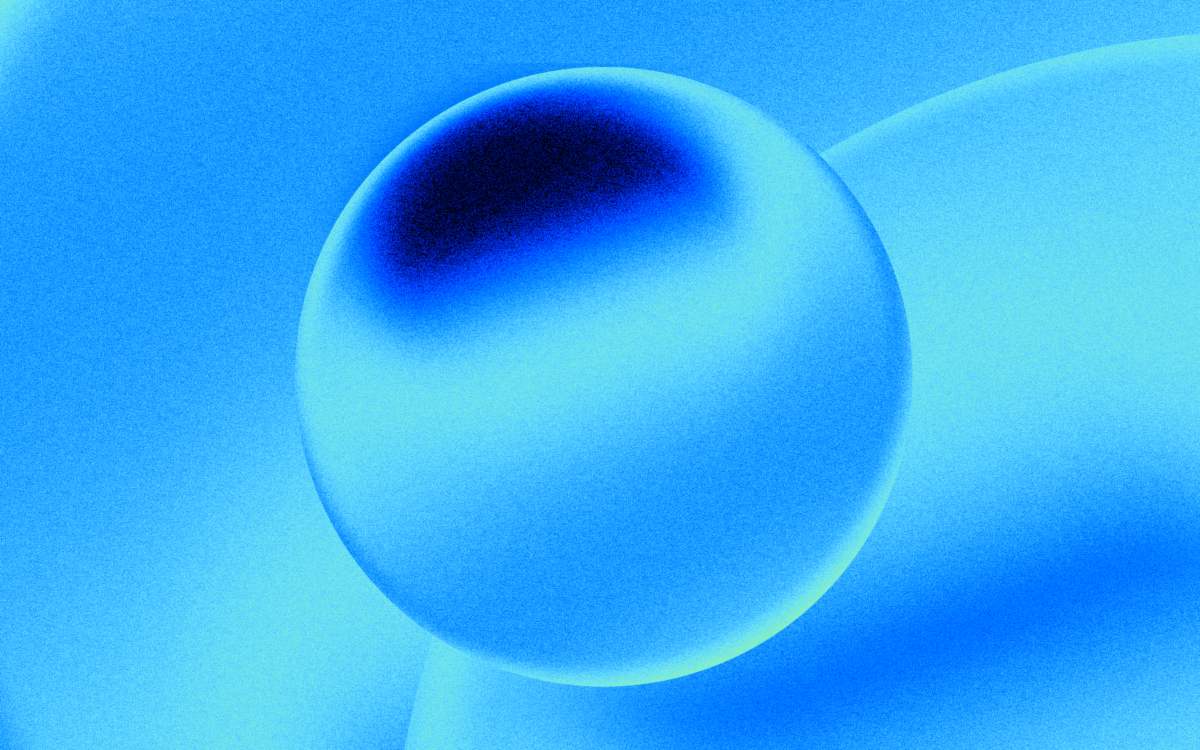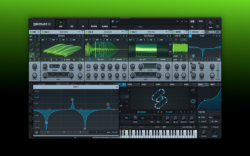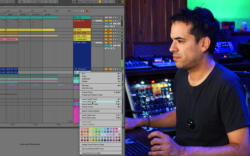Trance music emerged from the rave culture of the late 1980s and solidified its identity in the early 1990s.
While it derived its roots from house and techno, trance music distinguished itself through pulsating bass patterns and euphoric builds that transported its listeners. Where house and techno maintained their focus on hypnotic kicks, groovy basslines, and soulful sounds, trance shifted the emphasis to chord progressions and sweeping builds that prioritized melodic euphoria over pure rhythmic drive.
Like other dance genres, trance was born from that same culture of escapism, unity, and altered states of consciousness. But, trance took this concept further, crafting a sound specifically designed to deliver newfound transcendence to its audiences.
The genre’s name wasn’t accidental—it captured exactly what the music was meant to accomplish, creating those transcendent moments that lifted people beyond the ordinary experience of the dance floor.
What is trance music?
Trance music is a subgenre of dance music that’s characterized by its hypnotic rhythms, soaring melodies, repetitive structures, and those signature euphoric buildups that could stretch on for minutes.
While other dance genres like progressive house incorporate some of these elements, trance pushes them further by extending the breakdowns, layering in massive supersaw leads, and creating atmospheric soundscapes that feel almost cinematic in scope.
Trance music BPM
Trance’s tempo / BPM range really distinguishes it from its counterparts, typically ranging anywhere from 126 – 140 BPM. This sweet spot gives producers the perfect canvas for those extended breakdowns and dramatic drops that are the genre’s calling card.
Through sustained chord progressions and carefully crafted builds, trance taps into something deeper than just dance floor energy. The genre can evoke genuine emotional uplift and create a musical journey that keeps listeners invested from the first beat to the final fade.
The history of trance music
Trance music emerged in Europe during the late 1980s and early 1990s, particularly in Germany, the Netherlands, and the UK. It evolved from techno, acid house, and ambient music, often sharing clubs and DJs.
While the earliest forms were experimental and hypnotic, by the mid ’90s, trance had become one of the most popular forms of electronic music in Europe.
The origin of trance music
The earliest traces of trance can be found in the underground scenes of Frankfurt, Berlin, and London, where techno and acid house were dominant. German labels like Eye Q Records, Harthouse, and Masterminded For Success embraced this new sound, and artists like Sven Väth, Jam & Spoon, Cosmic Baby, and Paul van Dyk began creating more melodic, emotionally-charged variations of techno which were designed to send listeners into an altered mental state.
Along with several others, these early pioneers began blending the mechanical drive of techno with melodic progression and lush synth atmospheres, often invoking a psychedelic dreamlike state with their productions.
Some of the first tracks widely cited as trance music include:
“We Came In Peace” by Dance 2 Trance (1990): Often cited as one of the first trance tracks ever, “We Came In Peace” features a collaboration between Jam El Mar and DJ Dag, fusing ambient textures, tribal rhythms, and a steady techno pulse.
“The Age of Love” by Age of Love (1990): Produced by Bruno Sanchioni and Giuseppe Cherchia, “The Age of Love” is widely considered one of the seminal tracks in cementing trance as a genre.
“Stella” by Jam & Spoon (1992): A pioneering track from the German duo that combined cinematic synths with an emotional core, “Stella” helped define the melodic trance archetype.
“Perfect Day” by The Visions of Shiva (1992): A collaboration between Paul van Dyk and Cosmic Baby, this track brought a cleaner, more euphoric sound that leaned away from techno’s grit and more towards the soaring atmospheres that would characterize trance throughout the ’90s.
Early vs. modern trance
Early on, trance was quite different from its modern counterpart. These origin releases were typically slow-burning, built with analog synths such as the Roland JP-8000, TB-303, and TR-909 drum machines. The average duration of a trance song back then was anywhere from 8 – 10 minutes or longer, taking listeners on a euphoric journey that unfolded gradually, marking a stark contrast to the more linear structures of house and techno.
Having developed alongside the rise of European rave culture, clubs like Omen in Frankfurt and Tresor in Berlin were foundational to the birth of trance. These clubs offered late-night and all-night events where longer sets meant more room for extended mixes, paving the way for trance tracks to make their mark on the dance floor. All the while, UK clubs like Heaven and Ministry of Sound slowly began embracing trance as it crossed the English Channel, mixing with progressive and breakbeat influences.
By the early 1990s, trance began splitting from the underground and started forming its own distinct identity. What originally was an early fusion of techno, house, and ambient aesthetics slowly rolled out into its own unique identity.
Today’s trance can sound dramatically different from its early iterations. While genres like techno and house have largely honored their core foundations, trance has splintered into multiple subgenres, with some examples bearing almost no resemblance to what the genre sounded like in its first incarnation.
Despite these dramatic changes, trance has remained true to its essential purpose: creating an emotional journey through dance music. That core mission has expanded and diversified, allowing the genre to develop its own distinct sonic identity across multiple directions rather than following a single path.
Why is it called trance music?
The term “trance” was coined in the early 1990s to describe the emotional and psychological experience that the style invoked for its audience. The term was popularized largely by DJs, promoters, underground record labels, and producers alike.
Ravers would often describe the genre as beyond merely dancing—closer to a meditative, altered state of consciousness which was ultimately ‘trance-inducing’ due to its repetitive, hypnotic, and immersive nature.
By the early 1990s, compilations and record labels began to promote “trance” as a defining genre alongside house and techno, establishing the genre as its own unique style.
Trance music artists
Pioneers and influential artists
The genre’s earliest pioneers and most influential artists brought distinct signature sounds that helped define trance. While it’s impossible to make an exhaustive list, several producers and DJs stand out as the key ambassadors who shaped the genre’s foundation:
Paul van Dyk: An early global trance ambassador known for “For an Angel” (1994) and his emotive, uplifting sets. One of trance’s earliest global ambassadors, he’s known for his smooth, melodic style. His early albums 45 RPM (1994) and Out There and Back (2000) were milestones in the genre’s evolution.
Chicane: Known for blending trance with chillout and Balearic vibes. His track “Saltwater” (1999), which sampled Clannad’s “Theme from Harry’s Game,” became a crossover hit. Other notable tracks include “Offshore” and “Don’t Give Up” (with Bryan Adams).
Robert Miles: Though sometimes placed closer to dream trance or ambient, his track “Children” (1995) brought trance aesthetics to a global audience and became one of the most iconic electronic tracks of all time.
BT (Brian Transeau): An innovator in trance production and sound design who’s known for his cinematic and technical complexity. His landmark tracks include “Flaming June,” “Remember,” and “Dreaming.”
Modern artists
Tiësto: A key figure in pushing trance into stadiums and mainstream festivals. His early hits like “Suburban Train,” “Flight 643,” and his legendary remix of “Delerium – Silence (feat. Sarah McLachlan)” helped define the early 2000s trance sound. In My Memory (2001) and Just Be (2004) remain iconic albums.
Ferry Corsten: A prolific producer who released classics under many aliases including System F and Gouryella (with Tiësto). He helped solidify the Dutch trance sound and also contributed heavily to trance’s uplifting and anthemic direction.
Armin van Buuren: A global tastemaker and founder of A State Of Trance (ASOT), his weekly radio show that has shaped trance culture since 2001. His key tracks include “Communication,” “Shivers,” and “Blue Fear.”
Above & Beyond: A trio that brought emotional songwriting into trance through their projects like Group Therapy and Anjunabeats. Their key tracks include “Sun & Moon,” “Thing Called Love,” and “Good For Me.” Their fusion of progressive, vocal, and uplifting trance set a gold standard for musicality and emotion.
Subgenres of trance music
One interesting aspect of trance music is that it’s an evolving spectrum of styles that range from slow and meditative to fast and psychedelic. Over the decades, trance has branched out into multiple subgenres, each shaped by its cultural context, technical innovations, and emotional focus.
Below are some of the most influential subgenres, what defines them, and who helped pioneer them.
Progressive trance
Progressive trance emphasizes subtle builds and layered melodies rather than peak moments (like big drops). It’s slower than uplifting trance and places an emphasis on emotional tension, sonic storytelling, and evolving pads and textures. This subgenre often overlaps with progressive house, hence the name.
Tempo: 125 – 130+ BPM
Standout tracks:
- “Xpander” by Sasha
- “Tracking Treasure Down” by Gabriel & Dresden
- “Muhanjala” by Duderstadt
- “Formula Rossa” by Above & Beyond
Uplifting trance
Uplifting trance is the most melodic and emotional style of trance, often built around cinematic breakdowns, key changes, and soaring synth leads. It’s characterized by its positive energy and hands-in-the-air moments.
Tempo: 136 – 140 BPM
Standout tracks:
- “Till The Sky Falls Down” by Dash Berlin
- “Venice Beach” by Daniel Kandi
- “Sunset Boulevard” by Alex M.O.R.P.H. and Ana Criado
Tech trance
Tech trance blends the melodic elements of trance with the percussive, mechanical qualities of techno. It’s designed for more intense underground club settings and features gritty basslines, aggressive drops, and less emphasis on breakdowns.
Tempo: 135 – 142 BPM
Standout tracks:
What’s the difference between trance and psytrance?
Psytrance and trance share a common ancestry, and are often grouped together at festivals or in DJ sets—but it’s important to note that they differ significantly in terms of sound design, tempo, structure, and cultural roots. The main differences lie within not only tempo, but also rhythm and sound design.
While trance regularly ranges anywhere from 128 – 140 BPM, psytrance is typically faster, starting at 138 and going well into 150+ BPM ranges, and uses highly syncopated rolling basses that are more hypnotic and aggressive in nature.
In terms of sound design, trance relies heavily on rich chord progressions, supersaw leads, and melodic hooks, with clean arrangements consisting of clear builds and breakdowns. Pystrance, on the other hand, leverages sounds that are much more psychedelic in nature, which can feature glitchy effects, acid-style leads, otherworldly textures, and swirling modulations that continuously evolve.
While trance places its core emphasis on melody, psytrance is focused on delivering mind-altering sonic complexity.
The two can also differ widely when it comes to their arrangement and structure. While trance typically follows a clear intro → breakdown → build → drop structure, psytrance often employs minimal breakdowns and relies on constant movement, often using call-and-response patterns with layered loops to create a trance-inducing experience.
Another key difference lies in their cultural roots. Trance was born in the European rave scene, while psytrance can claim some of its roots to places like Goa, India, tying a strong connection to spiritually, psychedelia, and alternative counterculture.
Nowadays, psytrance hosts its own outdoor festivals all around the world, catering to its subculture and representing the genre’s ever-growing roster of artists.
How to make trance music
Making trance music can be daunting given the variety of subgenres and styles available. A starting point that might help is choosing a BPM within the 128 – 140+ range, where trance typically shines (this is the range most trance DJs traditionally spin).
After deciding on the BPM, the next obvious step would be to select a key. While this choice might seem mundane or arbitrary, it’s actually quite important since you’ll want to select a key that matches your favorite trance tracks for A/B-ing purposes.
Once you’ve selected your key and BPM, it’s time to make some sound design choices. Do you want to go for a modern approach, or lean towards a more traditional-sounding style of trance? Each of these choices will ultimately determine the final product and are worth considering at the early stages of making a trance track, particularly since the style of the drums, synth sounds, and effects can greatly impact the overall sonic identity.
Explore Splice’s library of royalty-free trance loops, one-shots, and presets.
Starting with a beat
Now that sonic choices and styles have been established, the next logical step is to begin with making a beat. Choose a clean and punchy kick with clear transients and low-end clarity. Trance kicks normally last slightly longer than house kicks, so look for any kicks that have a duration of around 200 – 300 ms (or more in some cases).
Next, select a synth that can deliver a trance-style bassline, such as Serum, Spire, Sylenth1, or Pigments. Many popular VSTs contain bassline presets that closely emulate traditional trance basslines, often with ready-to-go patterns.
From here, try adding a sidechain plugin like Kickstart or LFOTool. These plugins allow you to duck the bass signal so that kicks are present without muddying the low end of your mix.
Adding melodic movement
Trance is inherently melodic, and its emotion comes from strong, memorable chord progressions and harmonies. While trance songs can live in either minor or major keys, they tend to lean towards minor keys for emotional weight and expression.
To get inspired, try starting out with a simple arpeggio that sits on top of your bassline to get you in the groove. An arpeggio is often the foundational element that anchors all other melodic elements (like pads and leads).
For melodic and evolving movement, it’s crucial to automate different parameters of your arpeggio, such as the filter cutoff, envelopes, and effects like reverb and delay. All of these elements combined with a solid melodic pattern create tension and anticipation. Choose a pluck preset from your favorite VST to get started.
Trance pads, though often built upon simple detuned supersaws with 7 – 9 voices, unveil their captivating essence during transitions. Their true beauty emerges as filters on the chosen synthesizer sweep open, expanding and contracting before breakdowns and into drops.
Trance leads can range across a variety of sounds and styles, but ultimately, the most memorable leads are the ones that elevate the underlying chord progression, embracing delay and reverb atmospherics that take listeners on an emotional journey. Experiment with dotted 1/8th delays, heavy reverbs that range from 6 – 14 seconds, and layering multiple synths over the same pattern to achieve a massive wall of sound.
Conclusion
And there you have it! Hopefully this guide gave you a solid foundation on the history, key artists, subgenres, and production techniques behind trance music.
Do you have any questions on trance? What other genres would you like to see us explore next? Start a conversation with us and an ever-growing community of music creators via the Splice Discord.
Try adding some trance influences into your own music with Splice’s library of royalty-free loops, one-shots, and presets:
July 17, 2025

.svg)
.svg)




